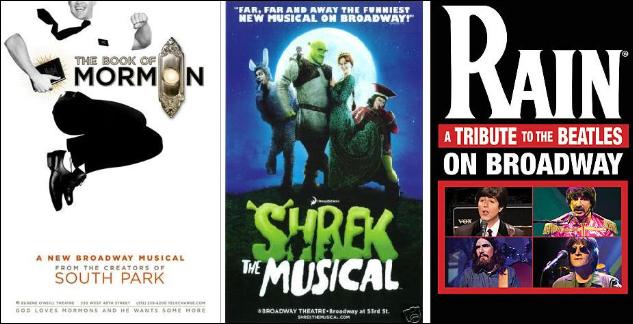Broadway, Rebranded

What’s the first thing you think of when you hear the word “Broadway”? New York City, musicals, The Phantom of the Opera, theater, and Fred Astaire might come to mind. These associations most likely exist because of the way in which Broadway has traditionally been branded for years – as expensive, prestigious entertainment.
Lately, as seen at the Tony Awards last night, Broadway has been undergoing a branding transformation. Dramas and white-bread musical comedies make way for new shows that target children, minorities, and even those who enjoy raunchy religious mockery (look up The Book of Mormon, winner of Best Musical from the creators of South Park).
Even so, Broadway walks a thin line between experimental target audiences and the musical purists of days gone. Many newer consumers are often reluctant to see shows because of the limited availability and expense of tickets. That’s why revivals of classics, like South Pacific and Gypsy, do well the second time around as older audiences remain steadfast in their support.
This puts Broadway at a complicated branding juncture. How can shows attract younger audiences with smaller wallets while still maintaining a reputation that’s made them star attractions for years?
For one thing, the quality of shows remains relatively unchanged. Performers are still top-notch, often putting commercial pop-stars to shame (sorry, Justin Bieber). These actors, plus costume designers, technician crews, and so many others, go into the making of one high-quality product — much in the way that a designer handbag à la Gucci is created — instead of cheaply manufacturing several low-quality items at a time.
Instead, what seems to matter most in Broadway’s rebranding is making shows accessible to everyone. Productions want the college undergraduate student or working suburban mom to see the latest show on tour in their hometown, not be intimidated by it. Maybe that’s why newer shows are increasingly turning to audience interaction; The 25th Annual Putnam County Spelling Bee used audience members as spelling bee participants alongside cast members, and the revival of Hair invited audience members to dance onstage in a psychedelic encore of “Let the Sun Shine In.” These experiences catapult audience members into the grandeur of the theater world, but in a way that is both comfortable and accepting for the participants.
Broadway is making progress on the road to rebranding; shows in the vein of Shrek the Musical and Rain: A Tribute to the Beatles are becoming more common, and overall show grosses have increased in recent years. In fact, Broadway theaters earned a cumulative $943 million between 2008 and 2009, the most ever in a single season. However, there’s still a long way to go before seeing a show is as common as going to the movies.
Which leaves the question: could a rebranding of Broadway ever really make it accessible to broader audiences? And, more importantly, is that what’s best for Broadway?
Contributed by Allison Meeks